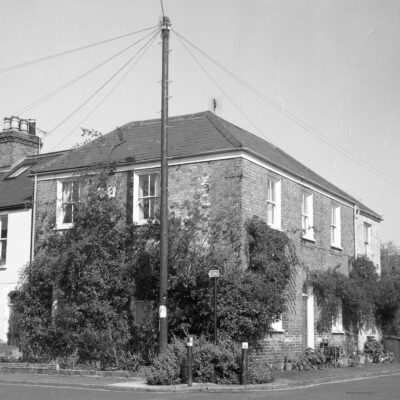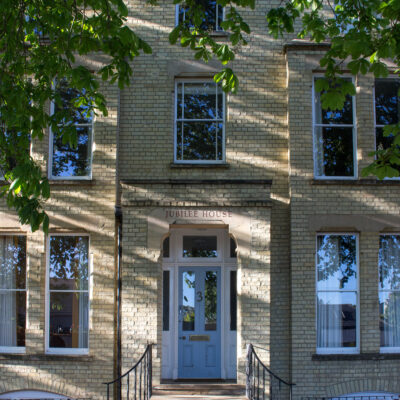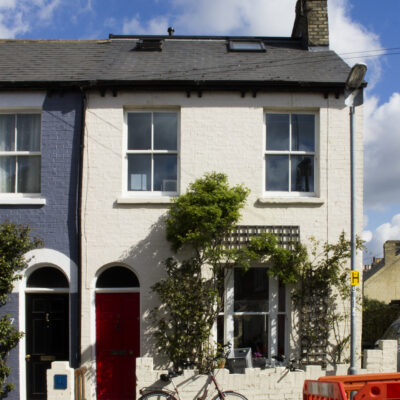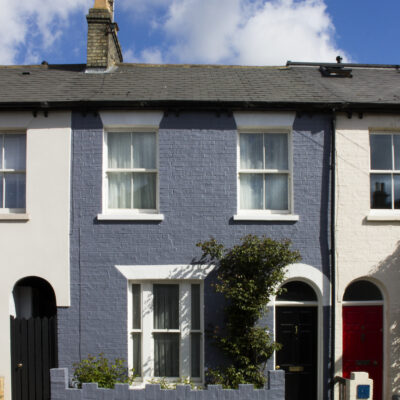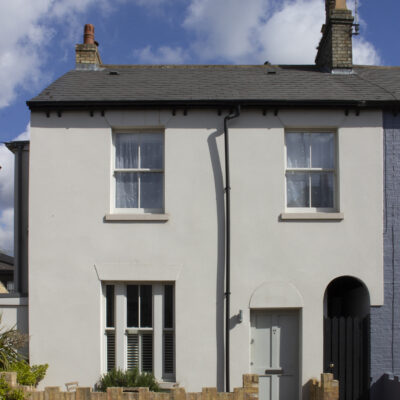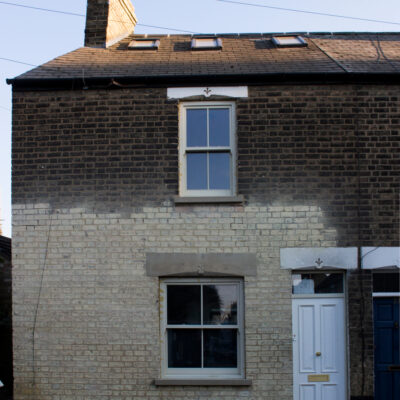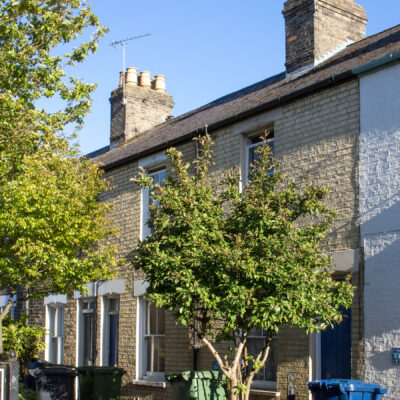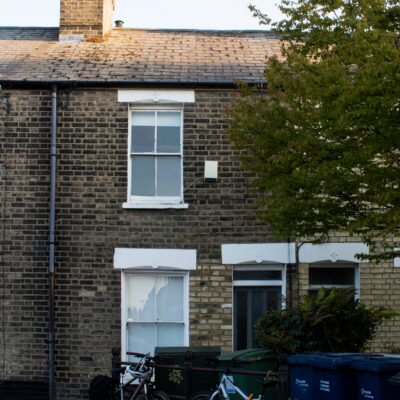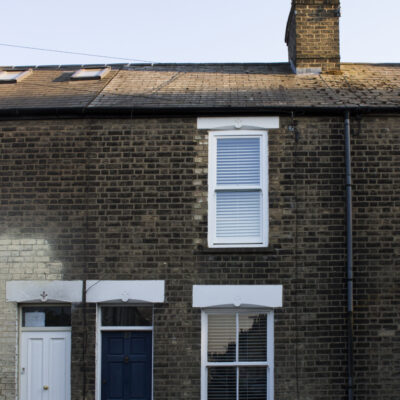Search by topic
- archaeology
- architecture
- bricklayer
- Building of Local Interest
- carpenter
- church
- crime
- dressmaker
- fire
- Great Eastern Railway
- listed building
- medieval
- oral history
- Public House
- Rattee & Kett
- Religious House
- Roman
- scholar
- school
- Then and Now
- tudor
- women
- work
- world war one
- world war two
Search by text
 Image kindly donated by Charles Hall of Hooper Street showing the coal wharf buildings in the 1950s
Image kindly donated by Charles Hall of Hooper Street showing the coal wharf buildings in the 1950sThe Coal Wharf, Hooper Street
The coal wharf on Hooper Street was located by the railway line opposite Calverley's in the 19th and 20th centuries
The Hooper Street coal wharf was on the south side of the street, on a site later occupied by Cambridge Women’s Resource Centre and now within the Ironworks housing development. It occupied a narrow wedge-shaped site between the railway line and Headly’s Eagle Foundry. From 1881 the site may have been used by William Saint’s Railway Building Works.
In 1900 the site became a coal wharf run by Coote & Warren Ltd., a coal merchant based in East Anglia and north London, and operating from the 1850s until 1960. They previously had a branch on Coldham’s Lane, and they had another branch in Hills Road by the railway bridge; see the Capturing Cambridge entry for Coote and Warren’s Coal Wharf, Hills Road.
In 1899 Coote & Warren had submitted plans to Cambridge Borough Council to build stables for the delivery horses and a house and office for the foreman. The plans are held at Cambridgeshire Archives in Ely (KCB/2/SE/3/9/1514). The buildings are those shown in the photo above, taken in the 1960s. The building at the rear is the stables, and the tall upper windows give access to a hay loft.
The house was used as lodgings for the wharf’s foreman and staff. By the 1950s the premises were used by D & H Contractors, and subsequently by Cambridge City Council as a depot for dustcarts. The house was demolished some decades ago, but the perimeter wall shown in the photo was still standing until January 2020.
1901 census
William Casey, 39, coal merchant’s foreman, b. Cambridge
Hannah Casey, 37, b. Cambridge
George Jarvis, father-in-law, 76, shoe maker, b. Cambridge
1911 census
William Casey, 49, coal merchant’s foreman, b. Cambridge
Hannah Casey, 47, b. Cambridge
Ethel Barker, visitor, 12, at school, b. London
Herbert A Ashman, boarder, 24, coal merchant’s foreman, b. Poplar, Middlesex
The first resident foreman was William Casey, who lived there with his wife Hannah. He had previously been the foreman of the Coldham’s Lane branch of Coote & Warren.
In 1901 William and Hannah shared the Hooper Street house with Hannah’s father George Jarvis, a boot maker.
In 1911 they shared the house with 12 year-old Ethel Barker, Hannah’s great-niece. Ethel’s parents, Charles and Mary, and five little brothers lived nearby in a very small cottage in Norfolk Terrace. Although described as a ‘visitor’ in the census, Ethel may have come to live with William and Hannah, who had no children of their own.
The local papers of 1907 (Cambridge Independent Press, 26 April and 24 May 1907) reported a curious legal case concerning William Casey. He had been sued by Henry Prior, an insurance agent, for £2 damage to a bicycle. Prior had been cycling down Hooper Street when ‘a dog rushed at his right leg, and then got in front and went for his left leg, and he became so occupied with the attentions of the dog that he did not notice a baker’s cart, which turned into the street from Ainsworth-street, and the consequence was that they collided.’ The horse then trampled on the bike, causing the damage. William Casey initially offered to pay for at least half the repair cost, but when he saw the bill he refused. After all, the damage had been caused by the horse and cart, not the dog.
The legal arguments centred on the nature of the dog. By the precedent of cases in which a dog caused an injury, the owner would be liable if he knew that the dog was dangerous. However, Casey testified that ‘the dog was a small fox terrier, which he had had between three and four years, and kept as a pet … His little girl took it out, and it followed her like a lamb. Hundreds of railway men came through his yard to get to their work, and the dog, which was of a quiet disposition, had never offered to touch any of them.’ The judge ruled that Casey was not liable.
In 1911 William and Hannah also had a boarder, Herbert Ashman, another employee of the coal wharf. Herbert was born in 1886, the eldest of four sons of Arthur and Belinda Ashman. Arthur was a coal merchant and, in 1901, the publican of the Railway Inn, Pampisford. Herbert went into the coal business like his father. In 1913 he was foreman of the Coote & Warren coal wharf on Hills Road, and in 1914 he was married. In the First World War he joined the Royal Garrison Artillery and was killed in action in 1918, leaving a widow, Ellen, and a baby daughter he had not seen since she was a few days old (Cambridge Daily News, 11 October 1918). Two of his brothers, Edward and Frederick, were also killed in the war. The three brothers are commemorated on the war memorial in Pampisford churchyard.
1921 census
John Wright, head, 29, coal wharf foreman, Coote & Warren, b. Gt Shelford, Cambridgeshire
Annie Wright, wife, 27, home duties, b. Rendlesham, Suffolk
In 1939 the Wrights were living there with their son John, aged 15, who had begun training as an instrument maker for Air Ministry Production. John Wright (senior) was still the coal wharf foreman in 1952.
In 1953 the premises – still known as the Wharf – became a scrap metal yard. By 1965 the Wharf was used by D & H public works contractors.
Sources
UK census records (1841 to 1921), General Register Office birth, marriage and death indexes (1837 onwards), and the 1939 England and Wales Register, electoral registers, trade directories, and local newspapers available via www.britishnewspaperarchive.co.uk. For Herbert Ashman’s death and military service, see e.g. https://www.findagrave.com/memorial/24603217/herbert-arthur-ashman.
For the history of Coote & Warren Ltd., see e.g. http://www.galata.co.uk/store.asp?storeAction=showDetail&stockID=4094. NB Most online sources say that the company was created as a merger of two earlier companies in 1908, but the full name ‘Coote & Warren’ appears in Kelly’s Directory as early as 1879. For Coote & Warren on Hooper Street, see e.g. Kelly’s Directory 1904, 1913, 1916, Spalding’s Directory 1935, and The Blue Book Directory 1938. For Coote & Warren on Hills Road, see also Kelly’s Directory 1892, 1896.
Contribute
Do you have any information about the people or places in this article? If so, then please let us know using the Contact page or by emailing capturingcambridge@
License
This work is licensed under CC BY-NC-SA 4.0








